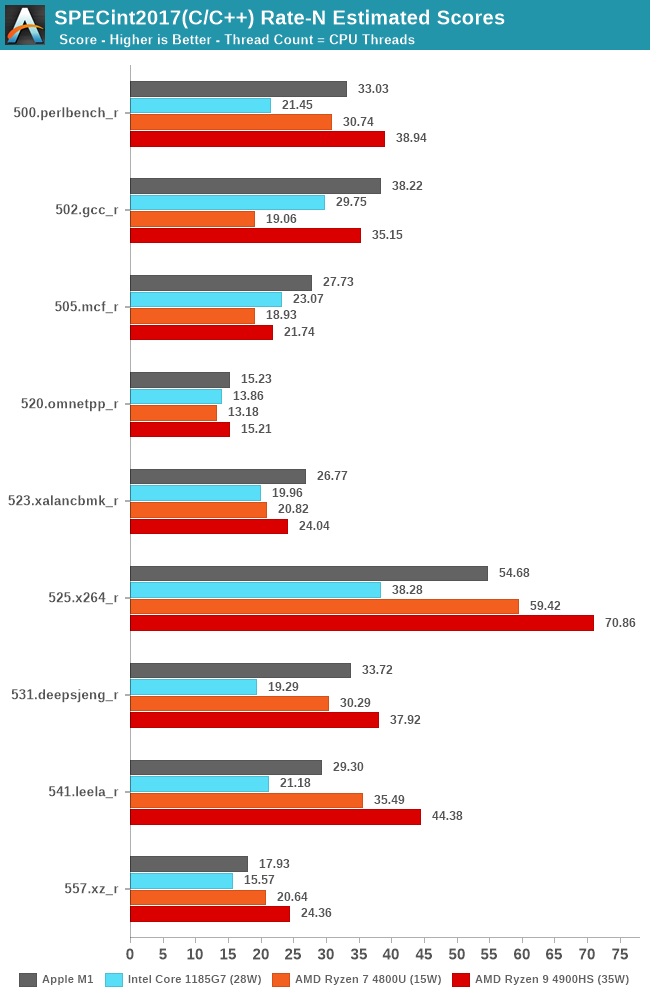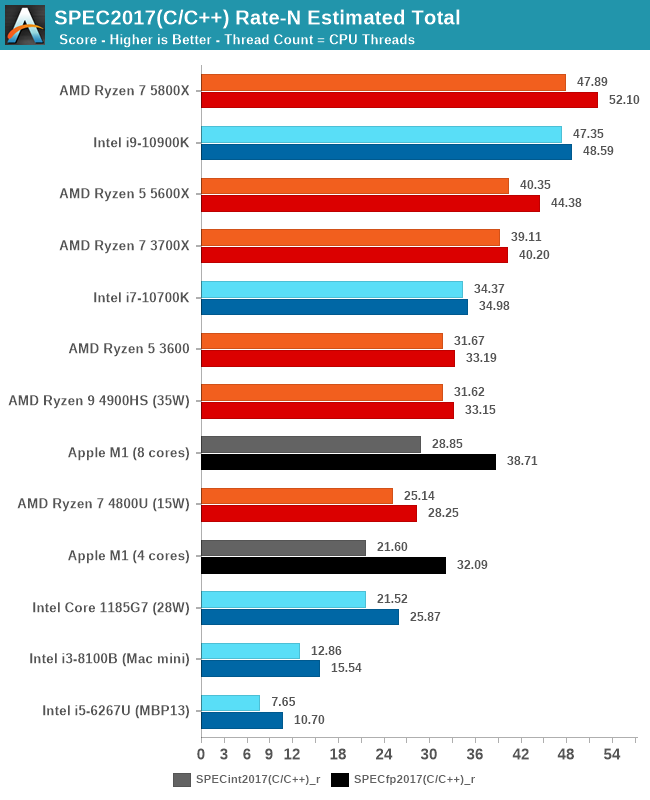The 2020 Mac Mini Unleashed: Putting Apple Silicon M1 To The Test
by Andrei Frumusanu on November 17, 2020 9:00 AM ESTSPEC2017 - Multi-Core Performance
While we knew that the Apple M1 would do extremely well in single-threaded performance, the design’s strengths are also in its power-efficiency which should directly translate to exceptionally good multi-threaded performance in power limited designs. We noted that although Apple doesn’t really publish any TDP figure, we estimate that the M1 here in the Mac mini behaves like a 20-24W TDP chip.
We’re including Intel’s newest Tiger Lake system with an i7-1185G7 at 28W, an AMD Ryzen 7 4800U at 15W, and a Ryzen 9 4900HS at 35W as comparison points. It’s to be noted that the actual power consumption of these devices should exceed that of their advertised TDPs, as it doesn’t account for DRAM or VRMs.

In SPECint2017 rate, the Apple M1 battles with AMD’s chipsets, with the results differing depending on the workload, sometimes winning, sometimes losing.

In the fp2017 rate results, we see similar results, with the Apple M1 battling it out with AMD’s higher-end laptop chip, able to beat the lower TDP part and clearly stay ahead of Intel’s design.

In the overall multi-core scores, the Apple M1 is extremely impressive. On integer workloads, it still seems that AMD’s more recent Renoir-based designs beat the M1 in performance, but only in the integer workloads and at a notably higher TDP and power consumption.
Apple’s lead against Intel’s Tiger Lake SoC at 28W here is indisputable, and shows the reason as to why Apple chose to abandon their long-term silicon partner of 15 years. The M1 not only beats the best Intel has to offer in this market-segment, but does so at less power.
I also included multi-threaded scores of the M1 when ignoring the 4 efficiency cores of the system. Here although it’s an “8-core” design, the heterogeneous nature of the CPUs means that performance is lop-sided towards the big cores. That doesn’t mean that the efficiency cores are absolutely weak: Using them still increases total throughput by 20-33%, depending on the workload, favouring compute-heavy tasks.
Overall, Apple doesn’t just deliver a viable silicon alternative to AMD and Intel, but actually something that’s well outperforms them both in absolute performance as well as power efficiency. Naturally, in higher power-level, higher-core count systems, the M1 can’t keep up to AMD and Intel designs, but that’s something Apple likely will want to address with subsequent designs in that category over the next 2 years.










682 Comments
View All Comments
YesYesNo - Tuesday, November 17, 2020 - link
It is also the fastest chip they have shipped so far.Spunjji - Thursday, November 19, 2020 - link
Useless response is useless.BushLin - Tuesday, November 17, 2020 - link
So what higher spec chip have Apple announced? There's lower spec versionsHrunga_Zmuda - Wednesday, November 18, 2020 - link
That there is a straw man. Apple practically never announces ahead of time what they are going to bring out.Spunjji - Thursday, November 19, 2020 - link
Apparently some people get up in their feelings when other people use the present to extrapolate to a likely future 🤷♂️BushLin - Thursday, November 19, 2020 - link
There's a difference between discussing what might be vs. "this is the slowest M chip Apple will ever ship" which to me sound like declaring a certainty... And the only people who are in a position to make such a statement is Apple, and they haven't.Spunjji - Monday, November 23, 2020 - link
It *is* a certainty. They've announced that they'll transition their entire range, which means more chips to come. The remaining products in the Mac lineup sit higher in the stack, so the next chips will have higher performance. Unless you can think of a lower product category in their lineup than the ones serviced by M1, there's no reason for them to release an M chip with a lower spec than this one - everything below the MacBook Air is already covered by A14.This is simple logic, and you're being needlessly obtuse.
BushLin - Monday, November 23, 2020 - link
Not obtuse. It wouldn't be out of character for apple to abandon the high end and target the M1for the much bigger market below that.Maybe you're right and there are higher clocked/higher core count versions on the way but the only certainty is in your mind.
Kirfkin - Tuesday, November 17, 2020 - link
I'm impressed. It's definitely better than I expected. I didn't think ARM performance would be there QUITE yet. It'll be interesting as more applications and games etc make it to Native ARM. I suspect performance will be up and down, but this is absolutely impressive.(I use both x86/AMD64 machines and ARM machines such as the Pinebook Pro; I'd absolutely love to see ARM succeed if it ultimately proves better).
haghands - Tuesday, November 17, 2020 - link
I really hope that somehow some of the engineering advances they've made with these chips are able to influence ARM IP in te rest of the industry. Obviously Apple doesn't want this and will in fact do everything in their power to prevent it, but I'm sure other vendors are studying these things closely and I hope it bears fruit lol. Who knows, maybe even some of their engineers leave Apple at some point to help build up some more open platforms, that's exactly what Chris Lattner of LLVM/CLANG and Swift did after all.